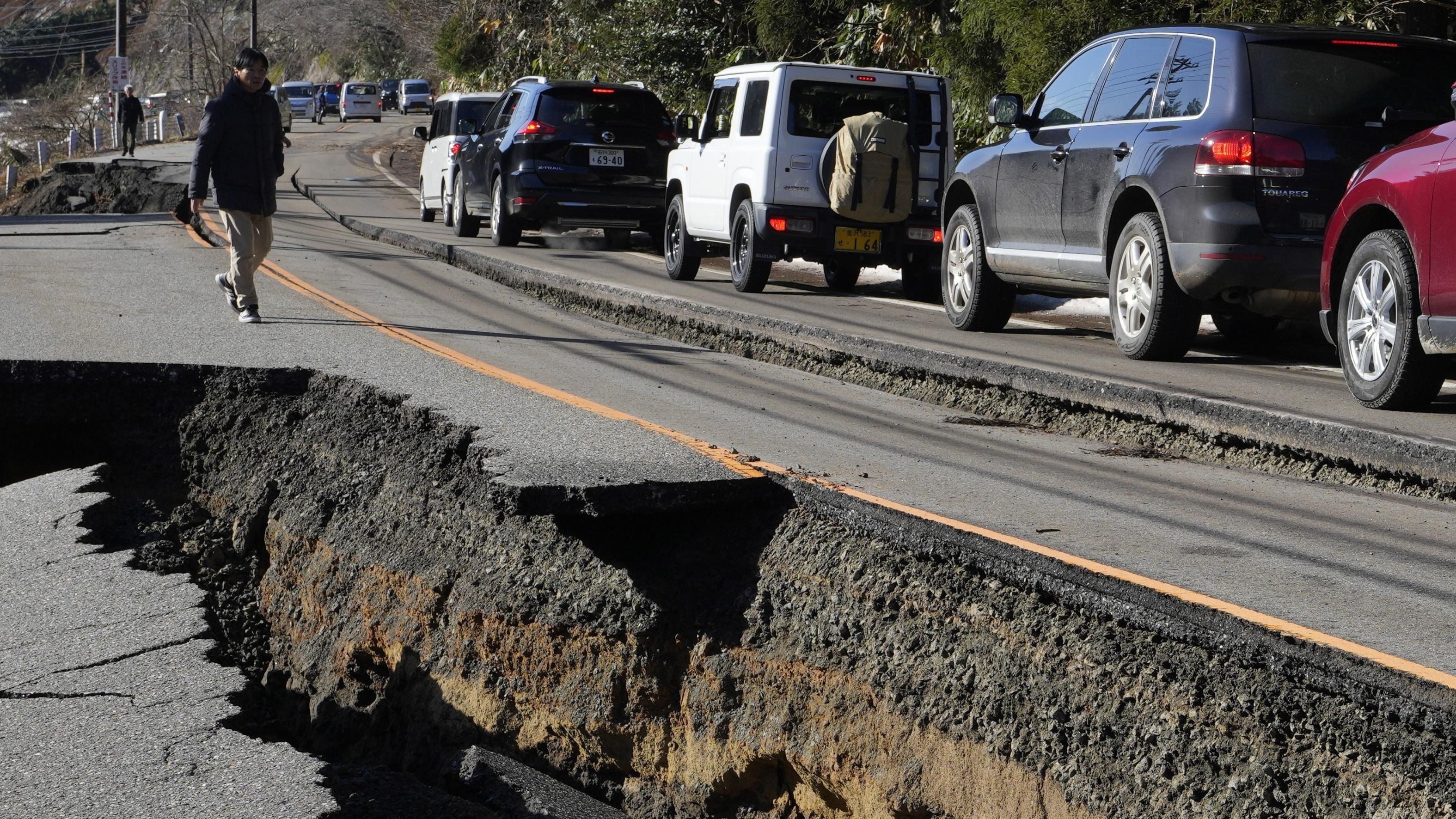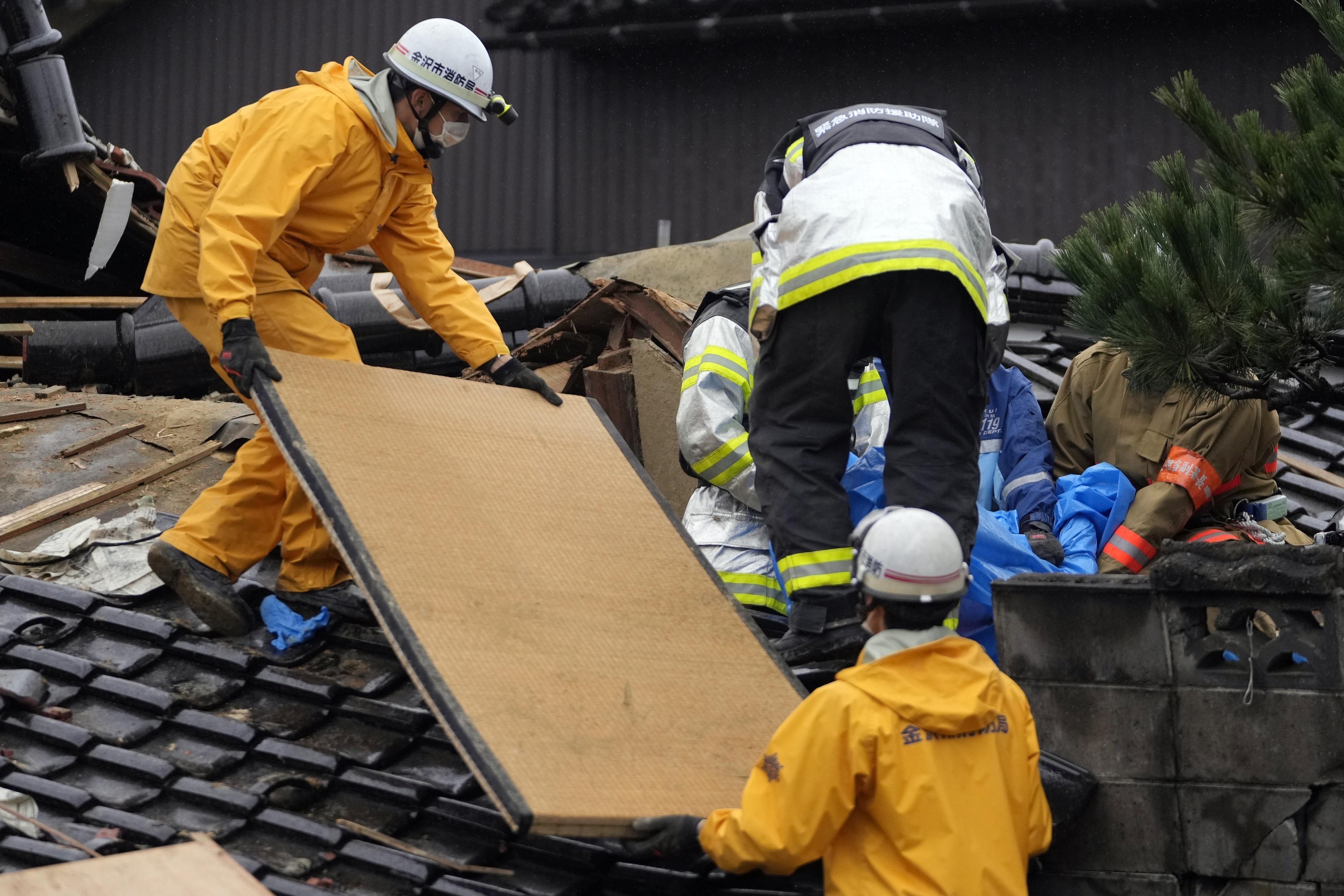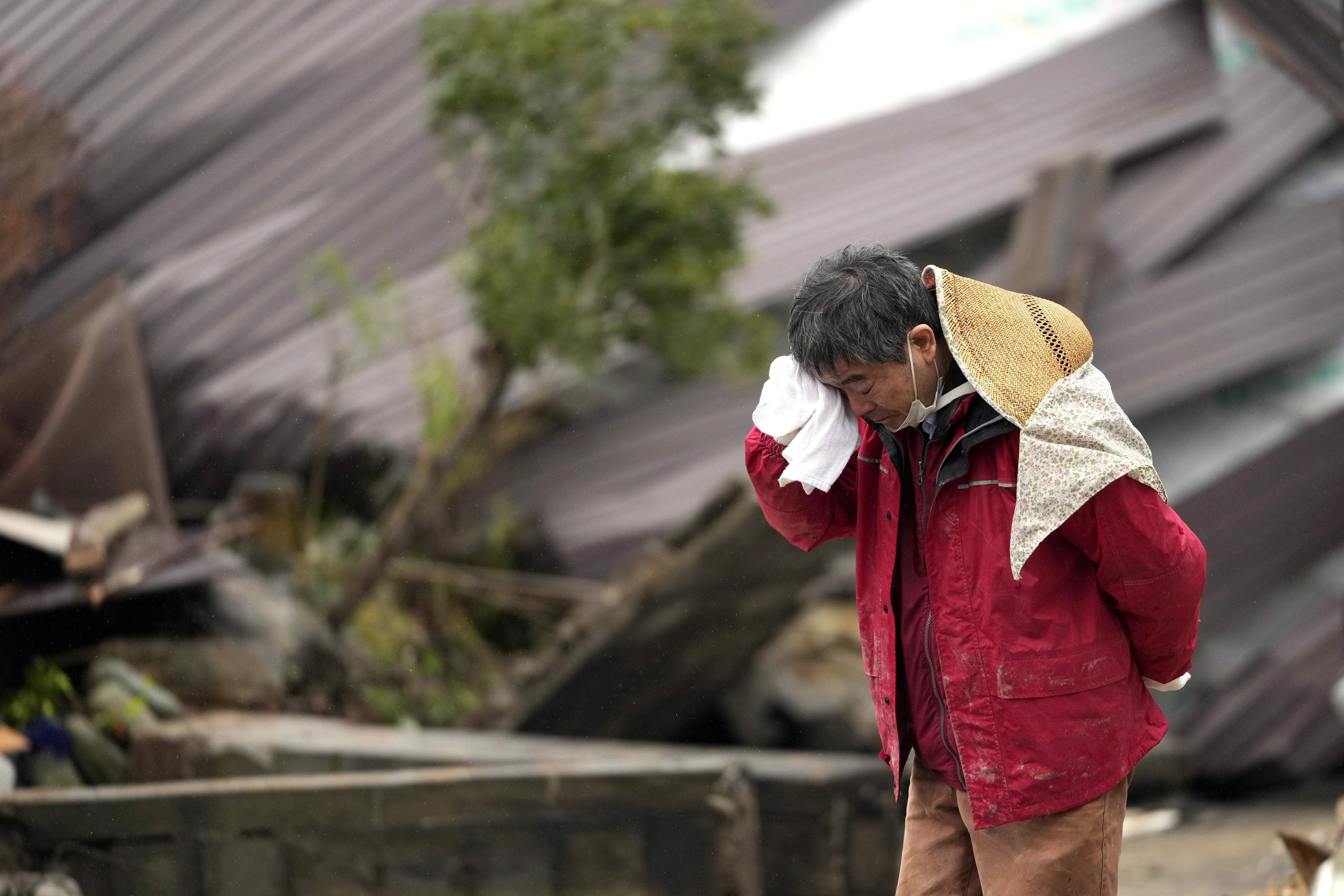 A traffic jam is seen on a partially collapsed road caused by powerful earthquake near Anamizu Town, Ishikawa prefecture, Jan 2, 2024. (KYODO NEWS VIA AP)
A traffic jam is seen on a partially collapsed road caused by powerful earthquake near Anamizu Town, Ishikawa prefecture, Jan 2, 2024. (KYODO NEWS VIA AP)
WAJIMA/KASHIMAJI/TOKYO - The death toll has risen to 73 in the central Japanese prefecture of Ishikawa as of 6 pm local time on Wednesday, after a series of powerful earthquakes hit the area in central Japan and the vicinity, with aftershocks and severe weather conditions hindering rescue work.
The most stricken city of Wajima in Ishikawa has confirmed a total of 32 deaths, reported the national news agency Kyodo, citing local authorities.
In a series of aftershocks experienced by the region, one with a magnitude of 5.6 on Wednesday morning and one with a magnitude of 4.6 on Tuesday evening struck off the Noto Peninsula, respectively, both at shallow depths and measuring upper 5 on Japan's seismic intensity scale which peaks at 7, according to the Japan Meteorological Agency.
The full extent of the quake remains unknown as rubble and severed roads still prevent search and rescue operations on Wednesday, two days after the 7.6-magnitude quake on New Year's Day caused extensive structural damage and fires in Wajima.
According to the prefectural government, at least 60 people are now in a state of isolation due to cut-off roads in at least three municipalities, including the severely stricken city of Nanao.
ALSO READ: Radioactive water spills over after quakes hit Japan
The National Institute for Land and Infrastructure Management announced on Tuesday that they detected a significant uplift in the ground surface, reaching approximately four meters in the city of Wajima.
The JMA issued warnings of potential mudslides for Ishikawa prefecture with intermittent rain expected through Thursday in the disaster-hit areas, including some cut-off villages. A heavy rain alert has been issued for the most-devastated city.
Ishikawa prefectural authorities have asked the central government to send Self-Defense Forces personnel for disaster relief, and the forces were set to use helicopters to deliver supplies to cut-off areas, according to local media reports.
Japanese Prime Minister Fumio Kishida instructed his government to ensure survivors have access to basic amenities including electricity and water.
"Please do everything in your power to rescue as many people as possible, while keeping in mind that this is also a battle against time," Kishida said during a disaster response meeting.
He said survivors may be unable to return home for some time.
Prime Minister Fumio Kishida said some 3,000 rescuers were finding it difficult to reach the northern tip of the peninsula where helicopter surveys had discovered many fires and widespread damage to buildings and infrastructure
ALSO READ: Japan's battle against time
Japan sits on the "Ring of Fire" arc of volcanoes and oceanic trenches that partly encircles the Pacific Basin. It accounts for about 20 percent of the world's earthquakes of magnitude 6 or greater, and each year experiences up to 2,000 quakes that can be felt.
Many rail services and flights into the quake area have been suspended. More than 500 people were stranded at Noto's airport which closed due to cracks in its runway and access road and damage to its terminal building.
Scores more have been injured and authorities were battling blazes in several cities on Tuesday and hauling people from collapsed buildings.
"I've never experienced a quake that powerful," said Wajima resident Shoichi Kobayashi, 71, who was at home having a celebratory New Year's meal with his wife and son when the quake struck, sending furniture flying across the dining room.
 Firefighters and rescue workers pull to carry a body, in blue sheet, found from a collapsed house caused by powerful earthquake in Suzu, Ishikawa Prefecture Jan 3, 2024. (KYODO NEWS VIA AP)
Firefighters and rescue workers pull to carry a body, in blue sheet, found from a collapsed house caused by powerful earthquake in Suzu, Ishikawa Prefecture Jan 3, 2024. (KYODO NEWS VIA AP)
Wrecked homes
Fujiko Ueno, a 73-year-old resident of Nanao city in Ishikawa, said nearly 20 people were in her house for a New Year celebration when the quake struck, splintering the walls which came crashing down on a parked car.
Miraculously, no one was hurt.
"It all happened in the blink of an eye," she said, standing next to the crushed car on a road littered with debris and mud that oozed out from cracks in the surface.
The Japanese government ordered about 100,000 people to evacuate their homes on Monday night, sending them to sports halls and school gymnasiums, commonly used as evacuation centres in emergencies.
Almost half of those evacuated had returned to their homes on Tuesday after authorities lifted tsunami warnings.
But around 33,000 households remained without power in Ishikawa prefecture after a night when temperatures dropped below freezing. More than 100,000 homes have no water supply.
ALSO READ: Runway safety concerns in focus as Japan probes Tokyo crash
 A man cries as a body of his family member was found from a collapsed house caused by powerful earthquake in Suzu, Ishikawa prefecture, Jan 3, 2024. (KYODO NEWS VIA AP)
A man cries as a body of his family member was found from a collapsed house caused by powerful earthquake in Suzu, Ishikawa prefecture, Jan 3, 2024. (KYODO NEWS VIA AP)
Nuclear plants
The quake also comes at a sensitive time for Japan's nuclear industry, which has faced fierce opposition since a 2011 earthquake and tsunami triggered nuclear meltdowns in Fukushima on the eastern coast. Whole towns were devastated and nearly 20,000 people were killed.
Japan last week lifted an operational ban imposed on the world's biggest nuclear plant, Kashiwazaki-Kariwa, which has been offline since the 2011 tsunami.
The Nuclear Regulation Authority said no irregularities were found at nuclear plants along the Sea of Japan, including five active reactors at Kansai Electric Power’s Ohi and Takahama plants in Fukui Prefecture.
Hokuriku Electric's Shika plant, the closest to the epicentre, has also been idle since 2011. The company said there had been power outages and oil leaks following Monday's jolt but no radiation leakage.
The company had previously said it hoped to restart the reactor in 2026.


